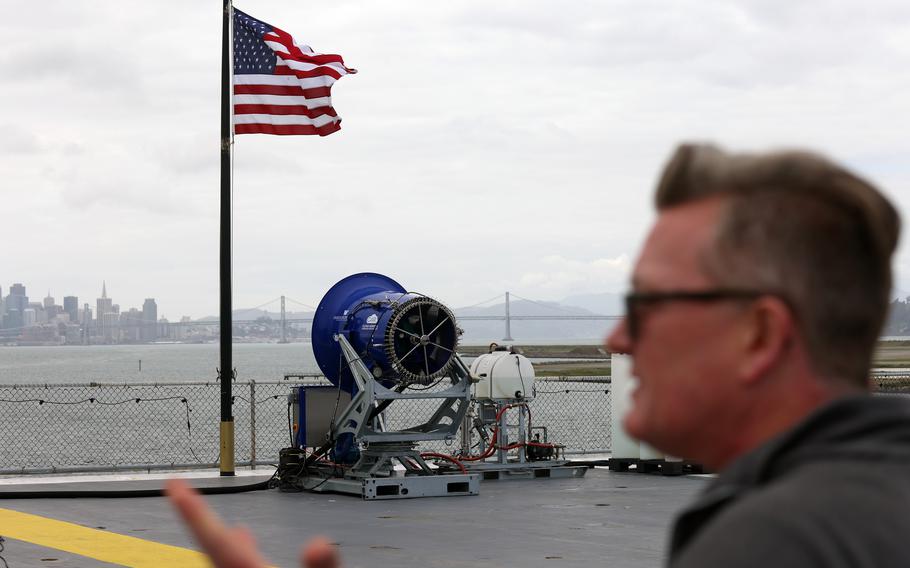
Dr. Rob Wood on the flight deck of the USS Hornet Museum with a Cloud Aerosol Research Instrument on Wednesday, April 24, 2024, in Alameda, Calif. (Aric Crabb, Bay Area News Group/TNS)
(Tribune News Service) — Prior to this month, researchers were using specialized machines to spray salt water into the air above a decommissioned naval ship docked in Alameda, Calif. Their ultimate goal? To test if those machines could be used to brighten low-lying clouds above the water in an attempt to cool down the planet.
Led by atmospheric scientists at the University of Washington, the experiment was part of a larger effort to find out if the warming effects of climate change could potentially be reduced by injecting salt aerosols into clouds, brightening them enough to reflect more sunlight away from Earth. But the project’s researchers were forced to stop earlier this month after the city of Alameda got word of what was going on.
According to a city press release, scientists were ordered to halt the experiment because it violated Alameda’s lease with the USS Hornet, the aircraft carrier from which researchers were spraying saltwater into the air using “a machine resembling a snowmaker.” The news was first reported by the Alameda Post.
“City staff are working with a team of biological and hazardous materials consultants to independently evaluate the health and environmental safety of this particular experiment,” the press release states. Specifically, chemicals present in the experiment’s aerosol spray are being evaluated to study whether or not they pose any threats to humans, animals or the environment. So far, there isn’t any evidence that they do, the city stated.
The prospect of a city-conducted review was not unexpected, the University of Washington said in a statement shared with SFGATE.
“In fact, the CAARE (Coastal Aerosol Research and Engagement) facility is designed to help regulators, community members and others engage with the research closely, and we consider the current interactions with the city to be an integral part of that process,” the statement reads. “We are happy to support their review and it has been a highly constructive process so far.”
The spray used in the experiment contained droplets of salt the size of about 1/1000th the width of a human hair, according to an info sheet published by the USS Hornet Sea, Air & Space Museum. Those droplets were sprayed in a plume of mist above the ship’s deck for about five to 15 minutes multiple times per day.
The research conducted onboard the USS Hornet was intended to learn how clouds respond to the aerosols present in the salt plume, not to brighten clouds, the university said in its statement.
Research into the efficacy of marine cloud brightening has increased over recent years, but there are still significant knowledge gaps as to how the process might impact climate patterns in the long term, according to a report published by the U.S. Department of Energy and the National Oceanic and Atmospheric Administration.
“The question is whether we can design a MCB research program using our current modeling and observational tools to establish the feasibility of this approach on a global scale, and if not, what needs to be done to position ourselves to do so,” NOAA researcher Graham Feingold said in a March blog post.
Findings from Alameda’s evaluation of the University of Washington experiment will be shared with the city council in June, according to the city’s press release.
(c)2024 SFGate, San Francisco
Visit www.sfgate.com
Distributed by Tribune Content Agency, LLC.